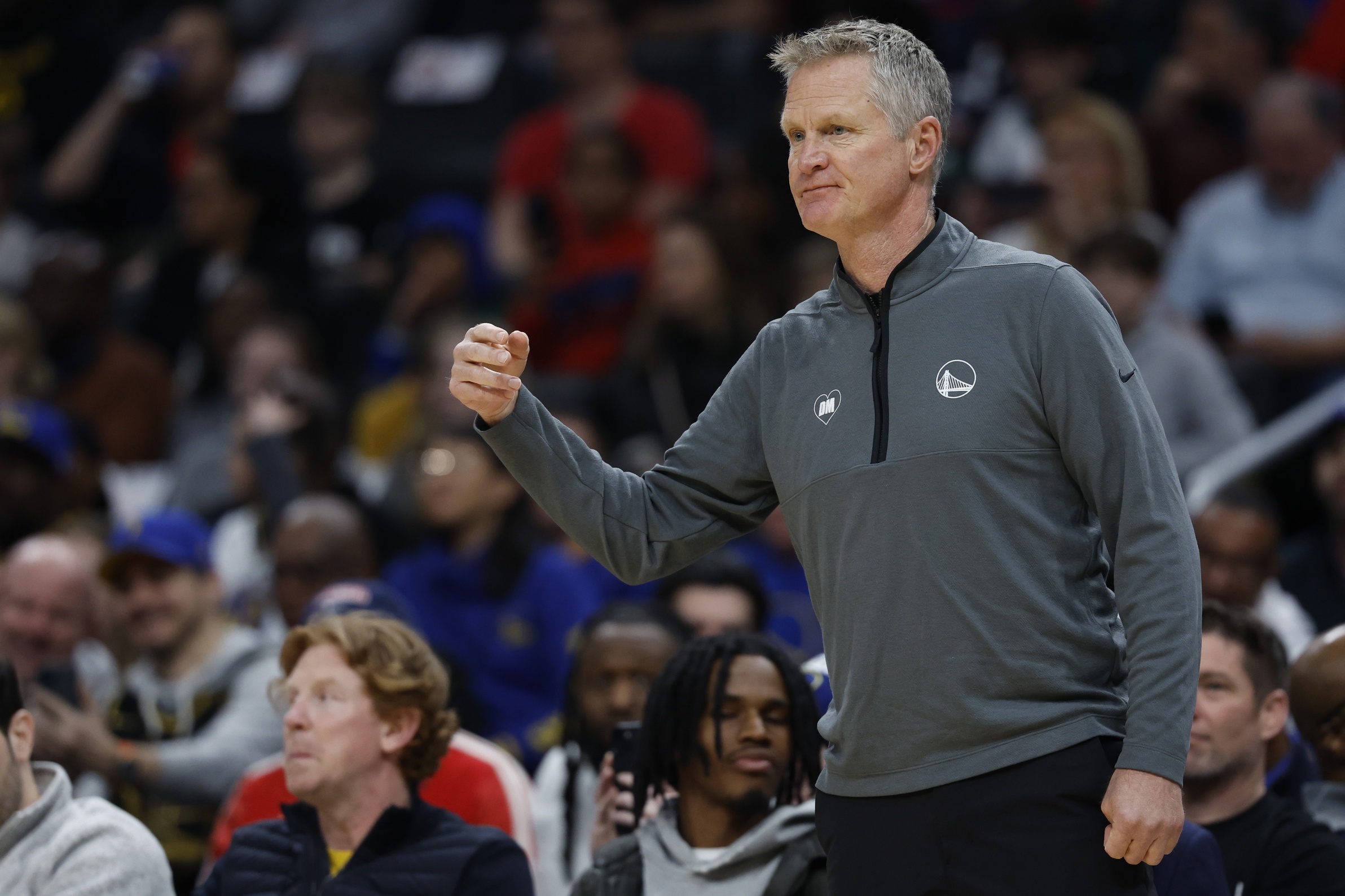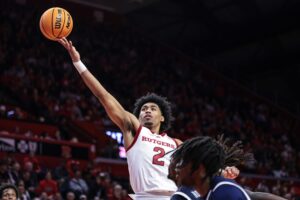For five months, watching the Golden State Warriors this season felt a bit like watching the Death Star implode. After a 5-1 start, Golden State went 14-23 over their next 37 games, capped off by a devastating 145-144 double-OT home loss to the Lakers. They sat at 19-24, out of the play-in picture and seemingly out of answers. Finally, it seemed, the empire was really crumbling and the Warriors’ playoff run was gone.
If the Warriors were really finished, someone probably should’ve informed them. Since their nadir at 19-24, they’ve found a new gear, winning 12 of their last 15. All of a sudden, they’re right back in the thick of things. The going’s been so good that head coach Steve Kerr was recently rewarded with a record-setting two-year, $35 million contract extension. It’s been a remarkable turnaround for a team that looked utterly hopeless just weeks ago.
Golden State did not merely flip a switch and go from a lottery team to a contender in the span of weeks. As always, there is context to consider, and the Warriors’ slow start had much more to it than just bad basketball. Between Draymond Green dealing with various suspensions due to on-court misconduct, Chris Paul missing a plethora of games through injury, and the tragic passing of assistant coach Dejan Milojevic, this season has been anything but kind to Golden State.
So, what happened? What finally clicked that’s kicking them back into gear?
The Three Things Spurring Golden State Warriors’ Resurgence
1. A Reinvigorated Defense
When we look back at this golden era of Warriors basketball, most of us will think about revolutionary offense. Steph Curry and Klay Thompson effectively ushered in our current era of basketball, where three-pointers reign supreme and the midrange is left to die. We’ll remember Kevin Durant as the cherry on top, a final piece that made the Warriors the ultimate offensive juggernaut.
But, if you’ve been paying attention, you know that Golden State’s defense is equally, if not more, important. In their four championship seasons, Steve Kerr’s defenses ranked 1st, 3rd, 11th, and 1st in defensive rating. Great Warriors teams have been just as good (if not better!) at defending the hoop then they were scoring on it.
That has not been the case this year. Even after a good February, Golden State ranks 18th in DRTG. Missing Green for large swaths of time hasn’t helped, but the internal regression elsewhere has been staggering. Most notably, Andrew Wiggins has taken a massive step back. With Wiggins as a primary defender, opponents are shooting league-average or better from every high-volume area of the floor.
This is not the norm for the long, switchy forward. Opponents’ overall FG% against Wiggins is 5% better than it was in Golden State’s 2022 championship season. Even if you don’t believe in advanced metrics, Wiggins is averaging near career-lows in both blocks and steals. In the modern NBA, you need quality wing defenders, and Wiggins has not been that player this year.
It’s not just Wiggins, though. Curry and Paul are too small to defend big guards, and Thompson no longer has the lateral quickness to help out. The entire starting lineup has regressed in DunksAndThrees’ dEPM, and Kevon Looney’s utter lack of rim protection is being exposed. Between the small, old guards, a lack of rim protection, and Wiggins’ regression, the Warriors’ defense has been too faulty to compete.
Steve Kerr’s Changes Paying Off
But, out of nowhere, the defense has sprung to life. Golden State is allowing six fewer points per game in February than they were beforehand. Benching Wiggins and Thompson for the younger, springier Jonathan Kuminga and Brandin Podziemski (or Moses Moody) is paying dividends. The February Warriors are blocking more shots, forcing more turnovers, allowing fewer threes, and fouling less. One (or both) of Kuminga and Podziemski is present in all of GSW’s five highest-rated lineups. Just by holding their own, they’ve given life to a flagging defensive unit.
2. Benching Klay Thompson
Steve Kerr took a massive gamble in deciding to bench Klay Thompson earlier this month. It was no small move – until recently, Thompson hadn’t come off the bench since his rookie season in 2012. It’s been an admittedly small sample size, but the move’s injected new life into both the Warriors’ starting lineup and Klay himself.
It’s little fault of his own, but Thompson’s clearly lost a step due to age and injury. The star version of Klay is no longer around; instead, he’s a streaky shooter and a negative defender. He’s shooting career-lows from both the field and behind the three-point line while recording his worst-ever dEPM. The team stats back up the personals – Golden State’s been nearly nine points better (per 100 possessions) with him off the floor than on.
Warriors Responded
But, since Kerr moved him to the bench six games ago, both Klay and the Warriors have bounced back. Bench Klay is averaging more points and assists in fewer minutes while shooting 4% better from the field and 9% better from three. His net rating has gone from a -1.8 rating as a starter to a +6.0 off the bench, and the Warriors are 5-1 in those games. To boot, these gaudy numbers include an ugly 1-for-9 performance against Utah; they could improve further with time.
It’d be remiss not to mention Moses Moody’s impact as a replacement starter, so I will. Since Moody’s introduction to the starting lineup, he’s been a revelation. Since becoming a starter, the 21-year-old is averaging high marks in every counting stat on a blistering 53% from the field and 40% from beyond the arc. His expanded minutes help the Warriors defensively, too. Moody grades out as GSW’s third-best rotational defender in dEPM, behind only Green and Kuminga.
Moody likely won’t shoot 53% forever, and Klay will probably endure cold streaks off the bench. But, for now, switching up the lineup is working. It remains to be seen if these trends continue, but the early returns are promising.
3. A Relaxed Schedule
I should begin by saying this section is not an indictment on the Warriors. The adage “You can only beat who’s in front of you!” rings as true as ever, and there’s value in every win.
However, this Warriors’ hot streak has coincided with an easy patch in the schedule. In their 11-for-14 stretch, six of those wins came against teams under .500, and two more came against an Embiid-less 76ers team. A would-be quality win against the Lakers was marred by LeBron’s absence, and they endured an ugly home loss against the Clippers sans Kawhi Leonard.
Still, it’s not fair to completely chalk this stretch up to weak opposition. In today’s NBA, anybody can beat anybody else on any given night; such is the impact of the three-point revolution. Good teams stack up wins against bad competition, and that’s exactly what the Warriors have done. There’s more on the way, too; Golden State has the 6th weakest schedule remaining, per Tankathon.
Not to mention, the Warriors recorded victories over the Knicks, Suns, and Pacers in this stretch. Sure, two of those teams were at less than full strength, but there’s plenty to be said for taking care of business.
Long story short, I wouldn’t discount this stretch simply because they aren’t beating championship contenders every night. Good teams take care of bad teams, and the Warriors are doing just that. More than anything, their recent weak schedule has given a struggling, uber-talented roster a golden opportunity to figure things out before they hit the playoffs. They battled through an incredibly difficult early schedule, and they’re reaping those rewards now.






